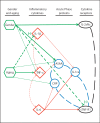Serum acute phase protein and inflammatory cytokine network correlations: comparison of a pre-rheumatoid arthritis and non-rheumatoid arthritis community cohort
- PMID: 23328621
- PMCID: PMC6741606
- DOI: 10.1159/000345700
Serum acute phase protein and inflammatory cytokine network correlations: comparison of a pre-rheumatoid arthritis and non-rheumatoid arthritis community cohort
Abstract
Serum concentrations of acute phase proteins, inflammatory cytokines, and other immunological components were individually assayed using high-sensitivity ELISA in a com-munity-based cohort of preclinical rheumatoid arthritis (pre-RA) and matched non-RA control (CN) subjects. Bivariate correlations of the biomarker panel concentrations were compared in pre-RA versus CN and female versus male subjects. Clinically elevated CRP levels (8+ mg/l) occurred in a higher (p = 0.010) frequency in 46 pre-RA (n = 8, 17.4%) subjects than in 179 CN (n = 9, 5.0%), and were independent of age, gender, smoking behaviors, and serum rheumatoid factor. Selected age and gender differences were found in levels of the immunological network factors. In each study group, the ratio of sTNF-RI to IL-2sRα mean concentrations was 2-fold higher in men than in women. Aging correlated positively with CRP, ASAA, and TNF-α levels, but negatively with IL-1β. Bivariate correlations were similar in pre-RA subjects versus CN and by gender, with few exceptions. Factor loadings in principal component analysis of the total subjects indicated that age- and gender-related variables constituted the two main components. Using multiple regression analyses, an integrative working model of all variable interrelations was generated. The tentative, directional model supports a concept of gender dimorphism of the ratio of sTNF-RI to IL-2sRα serum concentrations and displays differing effects of age on TNF-α versus IL-1β levels. These findings indicate complex age, gender, and cytokine interrelations in control of the immune systems network. Future research in testing such inflammatory pathways promises a better understanding of predisposition to diseases, like RA.
Copyright © 2013 S. Karger AG, Basel.
Figures




Similar articles
-
Inflammatory markers in patients with rheumatoid arthritis.Allergol Immunopathol (Madr). 2015 Jan-Feb;43(1):81-7. doi: 10.1016/j.aller.2013.11.003. Epub 2014 Mar 20. Allergol Immunopathol (Madr). 2015. PMID: 24656623
-
Increased mortality of incident rheumatoid arthritis versus matched non-RA control subjects: a community-based long-term prospective cohort study.Clin Exp Rheumatol. 2017 Mar-Apr;35(2):277-287. Epub 2016 Oct 26. Clin Exp Rheumatol. 2017. PMID: 27782866
-
Increased synovial fluid levels of interleukin-12, sCD25 and sTNF-RII/sTNF-RI ratio delineate a cytokine pattern characteristic of immune arthropathies.Eur Cytokine Netw. 2000 Dec;11(4):669-76. Eur Cytokine Netw. 2000. PMID: 11125312
-
Perturbations of hypothalamic-pituitary-gonadal axis and adrenal androgen functions in rheumatoid arthritis: an odyssey of hormonal relationships to the disease.Ann N Y Acad Sci. 1999 Jun 22;876:53-62; discussion 62-3. doi: 10.1111/j.1749-6632.1999.tb07622.x. Ann N Y Acad Sci. 1999. PMID: 10415593 Review.
-
Rheumatoid arthritis and periodontal disease: What are the similarities and differences?Int J Rheum Dis. 2017 Dec;20(12):1887-1901. doi: 10.1111/1756-185X.13240. Epub 2018 Jan 9. Int J Rheum Dis. 2017. PMID: 29341486 Review.
Cited by
-
Sexual Dimorphisms of Adrenal Steroids, Sex Hormones, and Immunological Biomarkers and Possible Risk Factors for Developing Rheumatoid Arthritis.Int J Endocrinol. 2015;2015:929246. doi: 10.1155/2015/929246. Epub 2015 Nov 26. Int J Endocrinol. 2015. PMID: 26693225 Free PMC article.
-
Circadian disruption and psychostimulants dysregulates plasma acute-phase proteins and circulating cell-free mitochondrial DNA.Brain Behav Immun Health. 2023 Jun 27;31:100659. doi: 10.1016/j.bbih.2023.100659. eCollection 2023 Aug. Brain Behav Immun Health. 2023. PMID: 37455861 Free PMC article.
-
Systems biology and innate immunity.J Innate Immun. 2013;5(2):97-9. doi: 10.1159/000347135. Epub 2013 Feb 21. J Innate Immun. 2013. PMID: 23428597 Free PMC article. No abstract available.
-
Lower Serum Androstenedione Levels in Pre-Rheumatoid Arthritis versus Normal Control Women: Correlations with Lower Serum Cortisol Levels.Autoimmune Dis. 2013;2013:593493. doi: 10.1155/2013/593493. Epub 2013 May 22. Autoimmune Dis. 2013. PMID: 23762532 Free PMC article.
-
Elevated adiponectin predicts the development of rheumatoid arthritis in subjects with obesity.Scand J Rheumatol. 2020 Nov;49(6):452-460. doi: 10.1080/03009742.2020.1753808. Epub 2020 Jul 15. Scand J Rheumatol. 2020. PMID: 32667228 Free PMC article.
References
-
- Akira S, Hirano T, Taga T, Kishimoto T. Biology of multifunctional cytokines: IL 6 and related molecules (IL 1 and TNF) FASEB J. 1990;4:2860–2867. - PubMed
-
- Gabay C, Cakir N, Moral F, Roux-Lombard P, Meyer O, Dayer JM, et al. Circulating levels of tumor necrosis factor soluble receptors in systemic lupus erythematosus are significantly higher than in other rheumatic diseases and correlated with disease activity. J Rheumatol. 1997;24:303–308. - PubMed
-
- Kushner I. Regulation of the acute phase response by cytokines. Perspect Biol Med. 1993;36:611–622. - PubMed
-
- Abeywardena MY, Leifert WR, Warnes KE, Varghese JN, Head RJ. Cardiovascular biology of interleukin-6. Curr Pharm Des. 2009;15:1809–1821. - PubMed
-
- Ganapathi MK, Schultz D, Mackiewicz A, Samols D, Hu SI, Brabenec A, Macintyre SS, Kushner I. Heterogeneous nature of the acute phase response: differential regulation of human serum amyloid A, C-reactive protein, and other acute phase proteins by cytokines in Hep 3B cells. J Immunol. 1988;141:564–569. - PubMed
Publication types
MeSH terms
Substances
Grants and funding
LinkOut - more resources
Full Text Sources
Other Literature Sources
Medical
Research Materials
Miscellaneous

